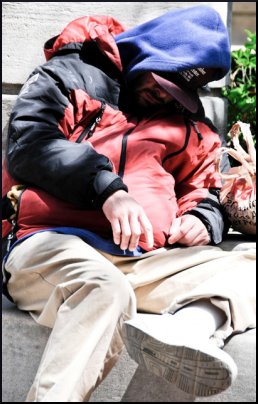
In the realm of homelessness, there is always more than plenty of regrettable news to talk about. For instance, the newest fad is people thinking it’s cute to take a “selfie” photo with somebody in the background sleeping on the sidewalk. Let’s just dismiss that trend as beneath contempt and get back to the count of people experiencing homelessness in America. House the Homeless has looked at several different aspects of it.
Confusion arises from the fact that there are really two different counts. Responsible for both is the local Continuum of Care, comprising the state and local governments and other government agencies concerned with housing, as well as private nonprofits and community mental health associations (i.e., public nonprofits). From them, every year, the U.S. Department of Housing and Urban Development demands an annual Point-in-Time count
of everybody in emergency shelters, transitional housing and Safe Havens on a single night.
In addition, every other (odd-numbered) year, the Continuum of Care in each place is responsible for counting the unsheltered. Confusion arises over who is sheltered and who is not. Ivy Farguheson, reporting on the situation in Indiana, puts it like this:
The count defines homelessness in a different manner than school corporations or social service agencies. That definition also changes from time to time. In the past, those sleeping on couches or staying temporarily in rooms of friends and family members could be counted as homeless and still are by Indiana’s school corporations and almost all local nonprofits. Now, those individuals and families are not counted as homeless under the HUD definition. Those court-ordered to substance abuse programs such as some men at the Muncie Mission or others paying small fees for housing, including many women at the YWCA of Muncie, can no longer be included in the numbers.
It seems like this could cause a lot of logistical problems. For instance, the CoC administrators also have to report to the appropriate federal agencies how many rooms or beds their facilities contain, so the government knows what resources there already are in a geographical area that’s asking for more money. So the bed has to be reported as existing. And the person occupying it is counted as “sheltered” even though it’s meant to be the most temporary of accommodations. Meanwhile, that person is not being counted amount the unsheltered, or true homeless. Depending on how the numbers are presented, it can look like more beds are available than actually are, or it can look like fewer people are totally unsheltered than actually are.
So much depends on this job being done accurately and conscientiously. Taking a census is, after all, the vital first step toward directing federal funds to the right places. But social policy reporter Mikel Livingston brings to light something most people have probably never thought about:
The number of homeless as determined by the count is not directly related to the federal dollars an agency or community receives. In other words, it’s nothing like public school funding, in which a certain number of students translates into a certain number of dollars. Instead, the count is one of many requirements for those entities to be eligible to apply for funding.
Livingston writes about Tippecanoe County, also coincidentally in Indiana, and about federal policy, which results in the homeless being “severely” undercounted. He mentions some of the many glaring contradictions. In his own state, the 2013 homeless total was down slightly from the 2012 number. But he gives examples to show that “the number of homeless clients who went through just one local shelter hints at a much larger population,” concluding:
There are several things the Point-in-Time survey is good for…. But judging the overall size of Tippecanoe County’s homeless population isn’t one of them.
…[I]n Indianapolis and surrounding Marion County, 1,599 homeless people were identified during the 2013 Point-in-Time survey. But an accompanying study from the Indiana University Policy Institute and the Coalition for Homelessness Intervention & Prevention estimated that between 4,800 and 8,000 people experienced homelessness during the year.
The sad fact is that House the Homeless could fill its pages with anomalies and discrepancies related to the Point-in-Time count until the next one rolls around. We remember the great advocate Mitch Snyder, who once made the suggestion that the homeless could be counted just fine, once they had been brought inside. What a great solution! Meanwhile we look forward to the day when the phrase “homeless count” causes people to scratch their heads with incomprehension, because there will be no people experiencing homelessness.
Reactions?
Source: “ ‘Counting’ the homeless: Official numbers don’t tell the story,” TheStarPress.com, 01/30/14
Source: “Homeless ‘Point-In-Time’ snapshot falls short,” jconline.com, 02/02/14
Image by Valerie Everett


